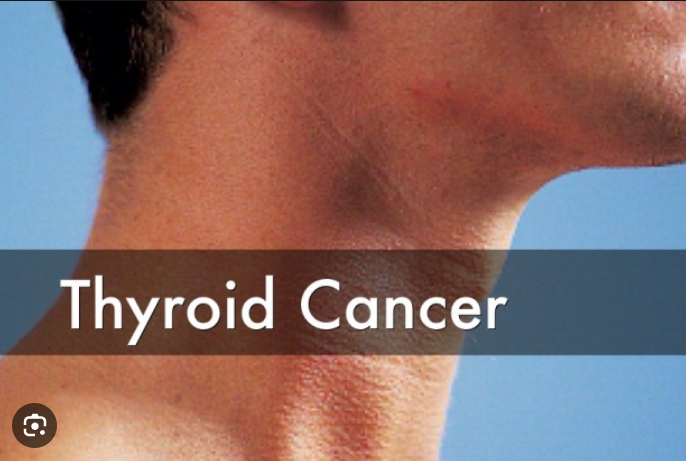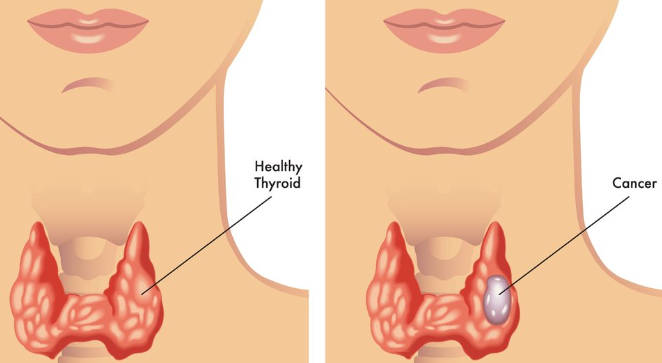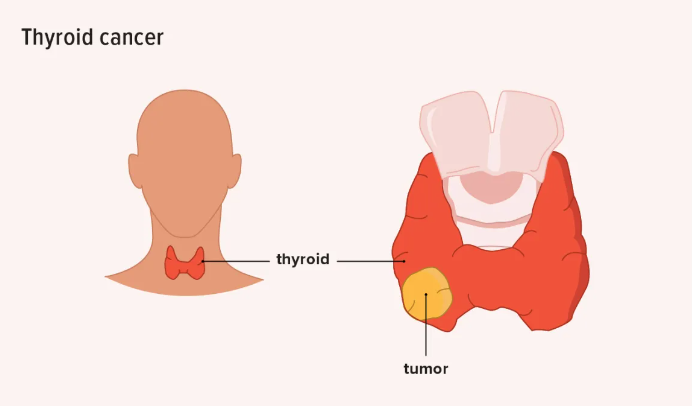Learn about the symptoms, causes, and treatment of thyroid cancer.
The thyroid gland is located in the lower front of the neck and resembles a butterfly. Its function is to produce thyroid hormones, which, according to Dr. Bryan R. Haugen, professor of medicine and pathology and head of the endocrinology, metabolism, and diabetes division at the University of Colorado School of Medicine at the Anschutz Medical Campus, “basically make everything in the body work more smoothly—metabolism, thinking, and other organs.”
Also read-Prostate Cancer : A Patient’s Guide to Prostate Cancer And Its Symptoms

The thyroid produces two extremely powerful hormones. According to the American Thyroid Association, the hormones help the body “use energy, stay warm, and keep the brain, heart, muscles, and other organs working as they should.” They are secreted into the blood and subsequently travel to every tissue in the body. Stated differently, these hormones are essential.
Types of thyroid cancer
The thyroid gland has two main types of cells. The first type, called follicular cells, uses iodine from the blood to make thyroid hormones, which help regulate metabolism. The second type of main cells, C cells, also called parafollicular cells, release the hormone calcitonin, which the body uses to regulate calcium.

Less common cells in the thyroid gland include immune system cells (lymphocytes) and supportive (stromal) cells. Each of these cells can develop cancer. The ACS says that “the differences are important because they affect how serious the cancer is and what type of treatment is needed.”
It is not uncommon for some type of growth or tumor, usually referred to as a nodule, to develop in the thyroid gland. Most thyroid nodules are benign, but about 10% to 15% are cancerous.
The main types of thyroid cancers, according to the ACS, are:
- Differentiated (including papillary, follicular, and Hürthle cells).
- Medullary.
- Anaplastic (an aggressive cancer)
Most thyroid cancers are differentiated cancers that develop from thyroid follicular cells.
Causes
The cause of most thyroid cancers is unknown, the ACS reports. Some genetic mutations have been identified with various forms of thyroid cancer. However, most of these changes develop in the person naturally over time and aren’t inherited from parents.

Risk factors for developing thyroid cancer include:
- Gender. Thyroid cancer, and in fact, most diseases of the thyroid, occur in women about three times as often as in men, for unknown reasons.
- Age. Risk rises as we age and reaches its peaks for women in their 40s or 50s when diagnosed and for men in their 60s or 70s.
- Family history. Though most people who develop thyroid cancer have no family history of the disease, having a family history does increase the risk.
- Iodine deficiency. This is generally not an issue in the U.S. because iodine is added to table salt and other foods.
- Radiation exposure. Exposure, especially as a child, to high levels of radiation, usually for treating other forms of cancer, increases the risk of developing thyroid cancer later in life. The risk from radiation for things like dental exams or the occasional broken bone isn’t fully known, though the ACS says that risk is most likely small.
“The most common risk factors for thyroid cancer are a strong family history and a history of radiation treatments to the head and neck area. Dental X-rays don’t count,” Haugen says.
Symptoms
Symptoms of thyroid cancer, the ACS reports, can include:

- A lump in the neck, which may grow quickly.
- Swelling in the neck.
- Neck pain, sometimes going from the front of the neck up to the ears.
- Chronic hoarseness or other voice changes.
- Trouble swallowing.
- Trouble breathing.
- A constant cough that’s not related to a cold or other upper respiratory virus.
Of course, many of these symptoms can also be caused by noncancerous conditions. And most nodules or lumps in the thyroid are benign and unknown to the patient. “Thyroid nodules are often asymptomatic,” says Dr. Megan Haymart, associate professor of medicine at the University of Michigan. “However, if there are large nodules, sometimes patients have difficulty breathing when lying flat or difficulty swallowing.”
Diagnosis
Developing any of these symptoms should lead you to your doctor to determine the cause and begin treatment, if necessary. Your doctor will take a medical history, do a physical examination of your thyroid for nodules or swelling and, if warranted, may order imaging studies to look for tumors. If a tumor is found, the doctor can take a tissue sample for biopsy to determine if it is cancer and what type it is, to determine treatment.

Treatment
Most cases of thyroid cancer can be cured by removing all or part of the thyroid through surgery. The surgery may include the removal of enlarged lymph nodes from the neck to test them for cancer cells that may have spread. If the cancer is very small, the surgery may remove only the side (lobe) involved.

“With surgery, the move or evolution has been to a less-is-more approach, similar to breast or prostate cancer,” says Sosa, who co-authored treatment guidelines released in 2015, which first allowed for the removal of just half of the thyroid for low-risk tumors. She is currently helping to write the next set of guidelines. “We are thinking about allowing some patients with small cancers of less than 1 centimeter be actively surveilled rather than have surgery. Many of these tiny cancers may be clinically insignificant,” she says.
After thyroid removal, patients will need to take thyroid hormone medication for the rest of their life. Medication replaces the hormones that the thyroid normally produces. It also lowers TSH levels, controlled by the pituitary gland, because TSH could cause any cancer cells left in the body to grow. Patients typically need blood tests to check thyroid hormone levels every few months at first, to find the proper dosage to stabilize their levels. Annual blood tests will follow.
Also read-Ovarian Cancer : A Patient’s Guide to Ovarian Cancer And Its Symptoms
images source: Google
Disclaimer: The opinions and suggestions expressed in this article are solely those of the individual analysts. These are not the opinions of HNN. For more, please consult with your doctor.




































